By Judith Elaine Halek
Photographs © Judith Elaine Halek

Women In Photography debuts an photographs and an article on
photographing water labors and births in the No. 8, Fall Issue,
October 1, 2001 Issue. The following is a rendition of the
article written by Judith Halek that appeared in this issue.
To view the website of Women in Photography, click here.
Archive 8 – WIPI News Article 3
| Documenting births has been an obsession of mine since 1987 when I assisted the first homebirth, waterbirth in New York City. Over the past fourteen years I have slipped in and out of one of the most intimate experiences known to life. I’ve had the privilege of documenting three separate environments; homes, hospitals and birth centers. My specialty is underwater birth. |
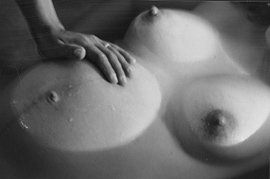
Waterbirth takes place when the baby is actually born from the womb of water inside the mother, to an extended womb of water, which could be a bathtub, a portable birthing pool, a jacuzzi, a water trough, or an ocean.
On my first contact with a couple, I give them a package of information and refer them to my website. After they have received the package and reviewed the site, we discuss what they like, what more they want and if whether there is a preference for a specific format, i.e., transparencies, and negatives, black/white, color.
Personally, I prefer to shoot with color negative because it offers more advanced emulsions. The additional color layers give better control in Photoshop. Black and white is the heart of photography, and from the purists point of view, film is superior to digital, yet, in the last three years technology has changed this. Today printing from a digital file with the special small gamut or monochrome black and white inks, creates a cutting edge print as acute as the traditional print from a darkroom.
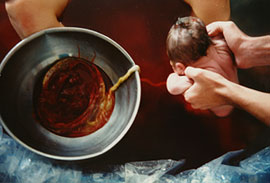
The first thing to establish is the due date. One can be on call
approximately three weeks before the due date and two weeks after, unless it will be a home birth where the post dates could last up to four or five weeks. We discuss whether the couple wants me to be at their home before they go to the hospital or birth center.
It’s imperative to have permission to photograph from the hospital or birth center. Put something in writing and submit it to the medical facility before hand. One doesn’t want to become an intruder and sometimes medical personnel can be security conscious. When parents create their birth plan, photographic permission ought to be included as part of the labor/birth.
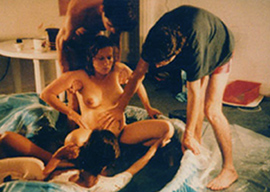
I work with the available light. Because of its invasive nature, I rarely use a strobe. I find available lighting creates a truer, softer,
journalistic reflection. I work with the fastest film for the camera:
Ilford and T-Max 400 and 800 for black and white and Fuji color (I find the skin tones are truer with Fuji). Sometimes I’ll be creative and shoot 1600 and 3200 when I’m at a home where candles are the only light source. I then utilize a monopod.I take anywhere between 5-8 rolls of film. I participate quietly in the labor and birth dance by making myself as inconspicuous as possible and shoot further away rather than close up. I work with the Canon EOS, SLR system; two cameras at a time with the Canon Elf as a third back up if we are transferring to the hospital or birth center. I use a EF 50mm f1:4 and EF 70-200 f1.2.8 lenses. I advise taking along a wide-angle lens such as a
21mm or 28mm for the confined areas.
When shooting, it1s important to focus on the details. Focus on becoming a Zen photographer and capture tender moments of father comforting mother, a gentle touch on a belly, a reflection in a mirror, a flower floating in water.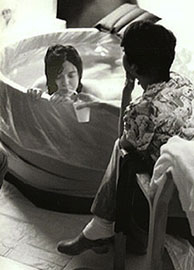 If you are fortunate enough to be invited into the OR in a hospital,
If you are fortunate enough to be invited into the OR in a hospital,
you’ll wear their sterile gowns. Pay attention to where you can and cannot be, and don’t touch anything! Take a small fanny pack for your film. In a birth center you can wear comfortable clothing to move around in, climb on top of tables, beds, chairs, or edges of the tub. A home birth environment is the most relaxed. Wear clean clothes, shoes that slip on and off easily, take time to use the bathroom, eat and hydrate yourself with something other than caffeine.Labors and births can take from 25 minutes to 18-20 hours. Patience and vigilance are the keys. It’s like covering a sporting event. You have no idea what’s going to happen minute to minute. Conserve your energy by breathing in such a way as to stay in a calm, neutral state, both mentally and physically. Most importantly, enjoy… the miraculous experience.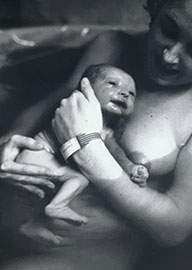
Judith Halek is the director of Birth Balance, the east coast resource center for under water birth. Judith is now in the process of moving her 15 years of photography out to the public. She has been published in numerous birth journals such as Midwifery Today, The Journal of Perinatal Education an ASPO/LAMAZE Publication as well as New York Magazine. She will be debuting her first solo show at a prestigious birth center in New York City this winter.
Her website is www.birthbalance.com
Her email is Judith@BirthBalance.com
Phone and Fax: 212-222-4349
*Judith Halek is among the photographers of
WIPI’s 20th Anniversary International Tea Time exhibit

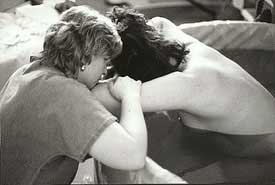


 ~
~ When one takes rolaids, it is COUNTER PRODUCTIVE to the absorption of the iron in the body. Rolaids is an ANTACID, (not acidic) and you NEED acid to absorb the iron in your body. So, you are just canceling out the iron supplement each time a rolaid is taken. It doesn’t matter if one takes one or ten…IT IS NOT GOOD! Research shows if a pregnant woman has to choose between chalk and rolaids, the more favorable choice is the chalk. It doesn’t have the antacid element to it. STOP rolaids immediately if your doctor has suggested this as a solution away from the chalk.
When one takes rolaids, it is COUNTER PRODUCTIVE to the absorption of the iron in the body. Rolaids is an ANTACID, (not acidic) and you NEED acid to absorb the iron in your body. So, you are just canceling out the iron supplement each time a rolaid is taken. It doesn’t matter if one takes one or ten…IT IS NOT GOOD! Research shows if a pregnant woman has to choose between chalk and rolaids, the more favorable choice is the chalk. It doesn’t have the antacid element to it. STOP rolaids immediately if your doctor has suggested this as a solution away from the chalk. Floradix is a liquid formula that will help to enhance the iron absorbtion in one’s body when eating iron rich foods.
Floradix is a liquid formula that will help to enhance the iron absorbtion in one’s body when eating iron rich foods. 1. Ferrous Phosphate: 6X or 12X strength, take 1-4 times per day, 4 pellets. This very useful cell salt is known as the “oxygen carrier”. It has the ability to carry oxygen to all the cells of the body for use in conversion to energy.
1. Ferrous Phosphate: 6X or 12X strength, take 1-4 times per day, 4 pellets. This very useful cell salt is known as the “oxygen carrier”. It has the ability to carry oxygen to all the cells of the body for use in conversion to energy. The 12 Tissue/Cell Salt Combination As the name implies, this is a combination of all 12 salts in a single tablet. This combination can be used daily in much the same way as you would take a vitamin or supplement. To treat specific conditions, however, select one of the single salts listed above. RECOMMENDED POTENCY – 6X is the most widely used potency. These are all the different MINERALS combined into the 12 Tissue/Cell Salts.Calcarea Fluoricum Calcarea Phosphoricum Calcarea Sulphuricum Ferrum Phosphoricum Kali Muriaticum Kali Phosphoricum Kali Sulphuricum Magnesia Phosphoricum Natrum Muriaticum Natrum Phosphoricum Natrum Sulphuricum Silicea (Silica)
The 12 Tissue/Cell Salt Combination As the name implies, this is a combination of all 12 salts in a single tablet. This combination can be used daily in much the same way as you would take a vitamin or supplement. To treat specific conditions, however, select one of the single salts listed above. RECOMMENDED POTENCY – 6X is the most widely used potency. These are all the different MINERALS combined into the 12 Tissue/Cell Salts.Calcarea Fluoricum Calcarea Phosphoricum Calcarea Sulphuricum Ferrum Phosphoricum Kali Muriaticum Kali Phosphoricum Kali Sulphuricum Magnesia Phosphoricum Natrum Muriaticum Natrum Phosphoricum Natrum Sulphuricum Silicea (Silica) Spinach is a source of non-heme iron, which is usually found in vegetable sources. Unlike heme iron found in animal products, non-heme iron is not as bioavailable to the body.
Spinach is a source of non-heme iron, which is usually found in vegetable sources. Unlike heme iron found in animal products, non-heme iron is not as bioavailable to the body.

 ~
~ Of course, I am in favour of the abolition of electronic fetal monitoring but it would be far more uplifting if this was being done for some sort of health improvement and not just more ways to cover butt in court.
Of course, I am in favour of the abolition of electronic fetal monitoring but it would be far more uplifting if this was being done for some sort of health improvement and not just more ways to cover butt in court. One of the midwife “tricks” that we were taught was to ask the mother’s shoe size. If the mother wore size five or more shoes, the theory went that her pelvis would be ample. Well, 98 percent of women take over size five shoes so this was a good theory that gave me confidence in women’s bodies for a number of years. Then I had a client who came to me at eight months pregnant seeking a home waterbirth. She had, up till that time, been under the care of a hospital nurse-midwifery practise. She was Greek and loved doing gymnastics. Her eighteen-year-old body glowed with good health, and I felt lucky to have her in my practise until I asked the shoe size question. She took size two shoes. She had to buy her shoes in Chinatown to get them small enough—oh dear. I thought briefly of refreshing my rusting pelvimetry skills, but then I reconsidered. I would not lay this small pelvis trip on her. I would be vigilant at her birth and act if the birth seemed obstructed in an unusual way, but I would not make it a self-fulfilling prophecy. She gave birth to a seven-pound girl and only pushed about twelve times. She gave birth in a water tub sitting on the lap of her young lover and the scene reminded me of “Blue Lagoon” with Brooke Shields—it was so sexy. So that pelvis ended the shoe size theory forever.
One of the midwife “tricks” that we were taught was to ask the mother’s shoe size. If the mother wore size five or more shoes, the theory went that her pelvis would be ample. Well, 98 percent of women take over size five shoes so this was a good theory that gave me confidence in women’s bodies for a number of years. Then I had a client who came to me at eight months pregnant seeking a home waterbirth. She had, up till that time, been under the care of a hospital nurse-midwifery practise. She was Greek and loved doing gymnastics. Her eighteen-year-old body glowed with good health, and I felt lucky to have her in my practise until I asked the shoe size question. She took size two shoes. She had to buy her shoes in Chinatown to get them small enough—oh dear. I thought briefly of refreshing my rusting pelvimetry skills, but then I reconsidered. I would not lay this small pelvis trip on her. I would be vigilant at her birth and act if the birth seemed obstructed in an unusual way, but I would not make it a self-fulfilling prophecy. She gave birth to a seven-pound girl and only pushed about twelve times. She gave birth in a water tub sitting on the lap of her young lover and the scene reminded me of “Blue Lagoon” with Brooke Shields—it was so sexy. So that pelvis ended the shoe size theory forever.





